Understanding Filipino traits, values, and culture
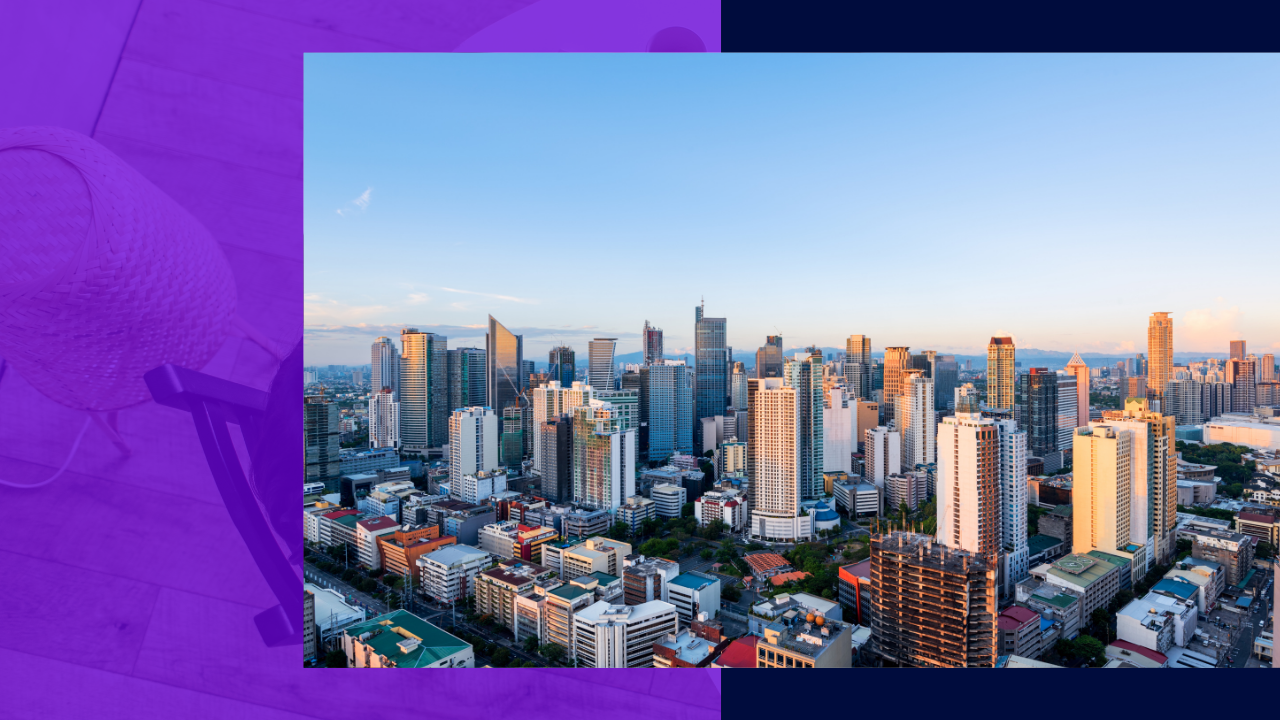
UPDATE: Coronavirus (COVID-19) is forcing a lot of companies to review their traditional staffing, offshore, and work-from-home (WFH) options. Outsourcing enables businesses to slash costs and, at the same time, maintain and rebuild their companies. Read our dedicated COVID-19 articles here: COVID-19 Business Recovery Action Plan
There are plenty of reasons why many businesses prefer to outsource their processes to BPO companies in the Philippines, and these include the high linguistic and cultural compatibility between Filipinos and their clients.
This factor not only affects the quality of service provided by the workforce. It also plays an important role in how office dynamics work.
To conduct a harmonious and effective working relationship, both parties should take the extra mile in familiarizing themselves with the culture and values of the people they are working with.
To understand the Filipino talent and the BPO industry in the Philippines, one has to take a look at the country’s history and understand Filipino culture and traditional values.
Top Filipino traits and values
The term kapwa, or a shared inner self, lies at the core of Filipino values and psychology. A person who treats another as a kapwa has a shared sense of identity and consciousness with that other person.
Both at the individual and community level, strong emphasis is placed on social acceptance and maintaining social harmony. As such, social approval and caring about what others will think, say, or do strongly influence social behavior.
Here are some of the common traits and values the country is known for:
The family
Filipinos are known to have strong family ties. This is why it’s common to see different generations or multiple families living in a single residence.
The family is at the center of the Filipino community. Children are not expected to leave their parents’ house until they get married. Even after then, many couples opt to stay with or close to their or their spouse’s parents.
Also, they’re expected to care for their aging parents instead of sending them to a retirement home.
The value that most Filipinos put into caring for one’s family can also be seen as one of the reasons why nurses and caregivers from the country provide their patients and clients with a high level of care.
Humor and positivity
Optimism, humor, and positivity are valued traits in the Philippines.
Filipinos love celebrations and festivities. The country has a long list of national holidays, and many provinces and cities have their own sets of local holidays. Meanwhile, they still find quality time for their families to celebrate birthdays, Christmases, and other instances.
At the same time, in the face of difficult or challenging situations, members of the community are encouraged to look at the brighter side of things. The inclination for finding the good in the bad can be traced to the country’s location, which lies in the path of typhoons and sits along the Pacific Ring of Fire.
In a place where natural calamities are commonplace, humor and positivity work as a coping mechanism, much like how some children laugh to hide their embarrassment after slipping or falling.
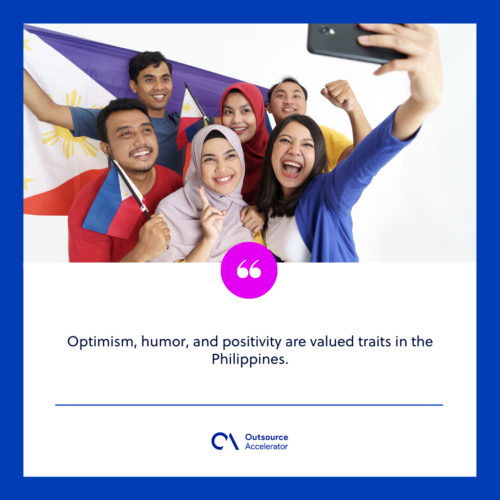
Flexibility and adaptability
The term bahala na, which can be translated to “whatever happens, happens,” is one of the more familiar phrases used in the country.
It is perhaps the most representative of how Filipinos value adaptability and quick thinking. The expression exemplifies one’s belief in a higher power and submitting one’s fate to elements that cannot be controlled.
People who use the term bahala na do not see anything wrong with it, as it serves as a sort of positive affirmation that allows them to deal with a problem right then and there.
However, those who call it a negative Filipino trait often view it as a form of fatalistic submission or a way to absolve one from the responsibility of their actions.
Faith and religion
Spirituality is deeply embedded in Filipino culture. A form of animism was already being practiced in many pre-colonial societies, and Islam had been firmly established in the southern islands even before the pre-Hispanic era.
These days, religion still plays a big part in society and the everyday lives of Filipinos.
The Catholic Church’s views still affect the passing of some laws, most towns still hold fiestas to honor their patron saints, and many regular non-working national holidays are dedicated to celebrating various religious activities and events.
To many Filipinos, religion helps shape their values and principles.
Filipino hospitality
Filipinos are naturally hospitable. Guests can be expected to extend a warm welcome to their guests regardless of where they come from, how well they know their host, and why they’re visiting someone’s home.
Hosts typically provide their guests with food and entertainment and, if there’s time, a tour around the local destinations.
In the Philippines, no one leaves with an empty stomach. Before they leave, guests are even entreated to take home pasalubong or souvenirs, which often come in the form of delicacies and local sweets.
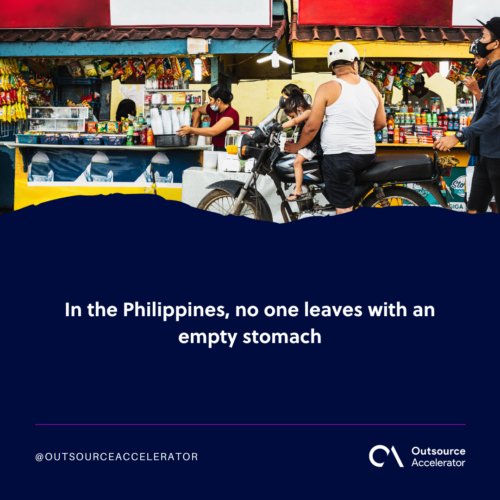
Other positive Filipino traits and characteristics
Aside from the ones mentioned, Filipinos also possess the following positive traits.
Respect for the elderly
Filipinos have high regard for their elderly, including their parents. Even young adults still practice taking their elders’ hands and saying “mano po” when they arrive at their homes.
Industrious attitude
Another one of the great characteristics of Filipinos is their being resourceful and industrious. They are determined to finish their set goals despite difficult circumstances and limited resources.
Generosity
Filipinos are naturally helpful and generous people. They give as much as they can and extend help to family members — and even strangers — when needed. This is seen through the abundance of charity drives and foundations in the country, especially when calamities arise.
Roots of Filipino values, traditions, and culture
To better understand how these Filipino values were shaped, we can take a look at the history of the Philippines and how other countries and cultures influenced the society in historic times.
Brief Philippine history
The pre-colonial Philippines
Long before the Spanish arrived in the Philippines, the communities in the archipelago have been trading with what is now China, India, Indonesia, Thailand, and Vietnam.
Its location beside continental Asia and along the border of the Pacific Ocean provided the archipelago’s inhabitants the chance to interact and communicate with different groups of people.
Some of the major influences in the country come from India and Arabia.
The Spanish occupation
The Spanish Colonial Period began with the arrival of the Spaniards in 1521 and ended in 1898—lasting a total of 333 years.
The islands were named The Republic of the Philippines in 1543, in honor of King Philip II of Spain. Christianity was also given heavy emphasis during this time.
The American occupation and beyond
After Spain was defeated in the Spanish-American War, the Philippines was occupied by America, Japan, and again, America after World War II.
By 1946, the United States had ceded its sovereignty over the country, and elections were held to elect the first president of the independent republic.
Languages of the Philippines
There are around 181 languages used in the Philippines. 131 of them are considered official languages, including Filipino and English.
It’s typical for Filipinos to grow up bilingual, and many even speak three languages — English and Tagalog plus the indigenous language in their region.
Philippine languages have been influenced by many other languages, including each other. In 1937, Filipino was named the National Language of the Philippines.
Spanish influence on the Filipino language
It is believed that a third of Filipino words are derived from Spanish.
During the Spanish occupation, friars and priests, with great reluctance and much delay, conducted religious instruction and almost all forms of formal education using Spanish under the orders of the Spanish government.
It was at this time that many Spanish words were borrowed into Tagalog.
American occupation and the English language
The American occupation saw the wide adoption of English as the language of instruction in schools throughout the country.
Before and after World War II, the Philippine government actively took solid steps toward establishing a national language based on Tagalog, which was used as a second language by almost half of the country’s population at the time.
In the present day, both Filipino and English are taught as academic subjects and used as languages of instruction in primary and secondary schools and universities throughout the country.
News and entertainment programs that are aired throughout the country are also often delivered in these languages.
Religion
More often than not, the Filipino people place their moral values in religion, particularly Catholicism and Islam. Religion is seen as a universal value that further strengthens the family and sometimes even affects the government in power.
This shouldn’t be an issue for business owners, since BPO in the Philippines is a major driving force for the country’s economic growth.
This loosens up the tensions between the Philippine government and foreign business owners and investors, making it easy for investments to go through and for businesses to receive tax relief on top of it all.
However, since Filipino talents have strong feelings about their religious beliefs, it’s best if you keep your conversations both professional and friendly when religion gets involved.
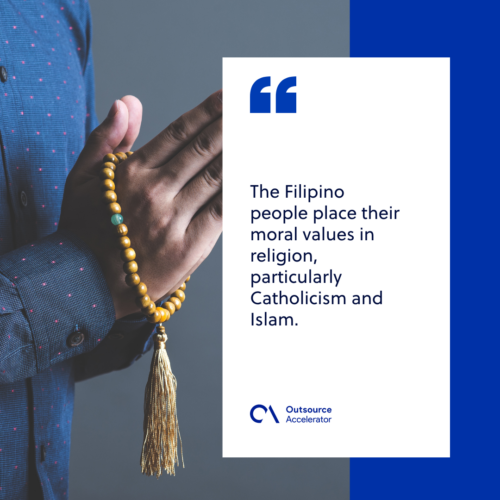
Filipino cuisine
Filipinos prepare great-tasting food, especially on special occasions with visitors around. Filipino cuisine is a mesh between Chinese, Mexican, Malay, Spanish, Indian, and American cooking.
It usually consists of six meals per day, including breakfast, snacks, lunch, brunch, dinner, and a final reach toward snacks to end the day on a full stomach. Most Filipino dishes involve rice, which is served alongside other edibles.
Most Filipinos regularly use spoons, forks, and knives to eat their food. But, sometimes hands come into play when seafood is involved.
Some of their most popular dishes include:
- Chorizo,
- Lumpia,
- Paksiw (pork or fish in vinegar and other spices),
- Kare-kare (a stew made of ox-tail),
- Sinigang (soup delicacy made of pork, prawns, or fish), and
- Longanisa (sweet sausage).
On the other hand, some popular snacks are bibingka (rice cake made with margarine or butter), polvoron (powder candy), puto (rice cakes), and chocolate.
Filipino work ethic
If you are considering hiring from or outsourcing to the Philippines, it’s important to understand the differences in culture so that you can get the best out of your workforce.
The Filipino workforce is some of the most loyal and hardworking people on the planet. They are very strongly community- and family-oriented, which should be reflected in the workplace and management styles.
It is hard to make generalizations, but Filipinos are very strong in more creative and communication-based roles — examples of this are design, content production, arts, and most customer-facing activities.
They are also very strong in English (spoken and written) — especially considering it is technically (historically) a second language for them.
To keep people motivated, engaged, and doing their best, they need to be happy and everyone needs to benefit from the relationship — it needs to be a win-win.

Philippines — a top outsourcing destination
Read this article to see why the Philippines is a top outsourcing (and employment) destination. Here, we have outlined some of the top reasons why the Philippines is the Swiss banking of outsourcing.
Managing a Filipino workforce
Managing people generally is not easy. To get the best out of a workforce, you have to invest heavily in the environment, and processes to ensure that you are providing adequate nurturing for their skills and career.
The workforce in the Philippines is no different. Properly managing a nurturing the workforce in the Philippines isn’t necessarily easy, but if you get it right, you can build an incredibly dedicated, loyal, and highly effective team.
We have written several articles covering these very items. Below are some recommendations:
Get the best from employing young professionals
This article reviews a recent podcast interview we had with Eileen Juan, the founder and “Queen Bee” of The Picture Company. She talks about how to motivate and get the best out of her Filipino workforce.
Get the best out of your Filipino workforce
This article explores the ways of getting the best performance possible from your Philippines-based team.
Resilience and adaptability of the Filipino workforce
This article summarises the learnings from our podcast interview with Gerrard Aguelles, a technical trainer and web developer. In this article, he explains how Filipinos are adaptable and how they respond to working with foreigners.
Payment solutions for Filipino workforce
The Philippines also keeps up when it comes to technology in payment solutions. This proves how far the country has gone when it comes to financial inclusion.
In a 2019 report by the Bangko Sentral ng Pilipinas (BSP), account ownership went up to 28.6%, good progress from 22.6% in 2017. Some of the unbanked citizens, meanwhile, place their money on mobile payment platforms.
With the rise of mobile payment and B2B platforms, transactions like receiving remittances, transferring allowances, and opening a savings account can now be done with a single click.
With this, Filipinos can spend more time with their loved ones and bond together with their friends. Businesses with a Filipino workforce don’t even have to worry anymore about excessive transfer fees when sending to different currencies.
Holidays in the Philippines
The Philippines is renowned for its national and local celebrations and festivals. They have wonderful celebrations, which focus on and celebrate many of the core values mentioned above. As a result of so much festivity, the country has more holidays than most other nations.
These holidays are briefly outlined below — and you can get full details of Philippine holidays here.
The Philippines has plenty of regular and special non-working holidays that celebrate national, religious, and cultural events. Regular non-working holidays refer to holidays with a fixed date, and schools and offices are typically closed on these days. These are:
- January 1 – New Year’s Day
- April 1 – Maundy Thursday
- April 2 – Good Friday
- April 9 – Araw ng Kagitingan (Day of Valor)
- May 1 – Labor Day
- June 12 – Independence Day
- August 30, or last Monday of August – National Heroes’ Day
- November 30 – Bonifacio Day
- December 25 – Christmas Day
- December 30 – Rizal Day
Special non-working holidays, meanwhile, refer to holidays that are enacted by Congress or declared by the president.
Some holidays may apply to academic institutions but may not affect business schedules or government functions. Some of the special non-working holidays celebrated in the country include:
- January 22, 2023 – Chinese New Year
- February 25, 2023 – EDSA Revolution Anniversary
- April 8, 2023 – Black Saturday
- August 21, 2023 – Ninoy Aquino Day
- November 1, 2023– All Saints’ Day
- December 8, 2023 – Feast of the Immaculate Conception
- December 31, 2023 – Last day of the year
Employees who work on regular holidays receive 200% the sum of their daily rate plus their daily cost of living allowance. Those who work on a special holiday, on the other hand, get 130%.
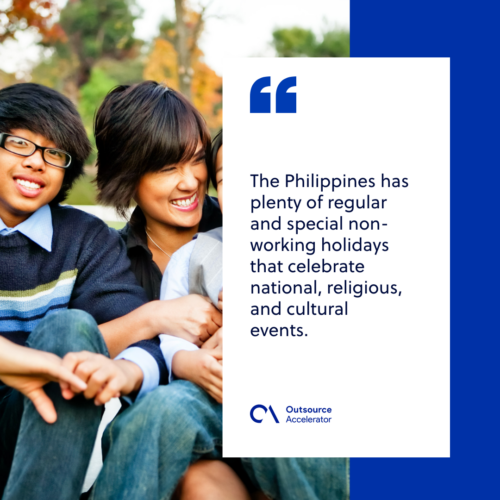
How Filipino culture and values benefit outsourcing
There are plenty of reasons why many businesses prefer to outsource their processes to BPO companies in the Philippines, and these include the high linguistic and cultural compatibility between Filipinos and their clients.
This factor not only affects the quality of service provided by the workforce but also plays an important role in how the office dynamics work. To conduct a harmonious and effective working relationship, it’s best if both parties take the extra mile in familiarizing themselves with the culture and values of the people they are working with.
Comprehensive guide to payroll salary compensation, benefits, and allowances in the Philippines
If you’re looking to hire people in the Philippines, especially if outsourcing, you should read our Comprehensive Guide to Payroll Salary Compensation, Benefits, and Allowances in the Philippines. It’s the most comprehensive guide to everything you need to know about salaries in the Philippines and all the associated considerations.
It also covers holidays and general allowances and expectations. As we mention above, there are a lot of holidays in the Philippines, and they are a core part of the culture and community.
Equally, there are a lot of allowances and peripheral things that you should know about when hiring a Filipino workforce (from within the Philippines).
Filipino salaries and income
the Philippine workforce earns considerably less than the workforce of the West. Sometimes this can be seen as unethical. But the Philippine economy is booming — it has been growing at above 6% year-on-year for the last 5+ years.
This is impressive growth. And it is largely fuelled by its young, and relatively well-paid workforce. A young Filipino graduate can live relatively well on a $300 monthly salary, as we explore in this article.
Filipino culture and values shine
The people of The Philippines can stand tall and be proud of their culture and values. It is an exciting time of rapid growth and relative prosperity for the people of The Philippines. And it couldn’t be more well deserved, or hard-earned.
Managing a team in the Philippines is not always easy — but then people management is a complex nuanced subject at the best of times. But once you have mastered it, the rewards are substantial — for all involved!







 Independent
Independent




